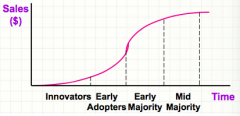![]()
![]()
![]()
Use LEFT and RIGHT arrow keys to navigate between flashcards;
Use UP and DOWN arrow keys to flip the card;
H to show hint;
A reads text to speech;
12 Cards in this Set
- Front
- Back
|
What is consumer behaviour all about in marketing ? |
1. identifying target market 2. consumer decision making 3. identify consumer's perceptions of products, brands and stores 4. identify unmet needs 5. discovering how attitudes can be by advertising |
|
|
What are the steps involved in decision making process of an individual ? |
1. recognise problem and needs 2. pre-purchase research 3. Evaluate alternatives 4. Purchase 5. Post-purchase evaluation |
|
|
What are the external factors that influences individual's decision making process? |
1. External socio-cultural environment 2. Firms marketing effort 3. Purchase situation |
|
|
What are the socio-cultural factors that could influence individual's decision making process ? |
- family : as children's knowledge and skills are given buy their parents - culture - social class : educational attainment, occupational status, income - reference groups : a person or group that serves as a point of comparison for individual in forming specific attitudes, values or behaviour |
|
|
What are the psychological influences on individual's decision making process? |
1. Learning and brand loyalty 2. Personality 3. Mood 4. Attitudes |
|
|
What happens in problem/need recognition, give examples ? |
- Motivation (negative / positive) - Level of needs (Maslow's hierarchy of needs and related products) - lower-level needs (water,sleep,food,staple items) - higher-level needs (cars, furniture, credit cards) |
|
|
What is involved in pre-puchase research ? Elaborate. |
- experience: consumers' previous purchase within a same category - product involvement : - if it is high risk the item requires more research (to reduce purchase risk) before purchase - if it is low risk and low involvement goods, usually consumers falls into habitual behaviour in purchase |
|
|
What happens when evaluating alternatives ? |
- Evoke set : specific brand a consumer considers in making their decisions - criteria used to evaluate brands: involves compensatory / non-compensatory rules - compensatory rules: evaluates all aspects of a product - non-compensatory rules: one poorly performed aspects in a product cannot be overcome by other good aspects in the product |
|
|
How does personality play a role in determine consumers' response to environment/marketing a product ? |

- close relationship between personality and product life cycle - innovators, early adopters, early majority, mid majority - innovators can be distinguished from non-innovators by marketer by traits of dogmatism, risk aversion |
|
|
How does mood play a part in allowing marketer to influence individual's decision making ? |
- mood is a short lived emotions - can be influenced by environment, salespeople and marketing communications employed - If employed at the right place and right time can encourage people to buy more products |
|
|
How does marketer determine consumer's perception on their product ? and how do they interpret information they obtained ? |
- employing perceptual map - positioning of their products tells them consumer's perception of their product. - like they position it as high-end product due to the price and quality that might cause them to perceive the product as luxury goods and not staple goods. - can also show good picture of their product with their competitors |
|
|
How is brand loyalty established through the understanding of consumer behaviour ? |
- Post-purchase - if they like the product / or receives good service - good experience is created - leads to repeat purchase - and if the expectation is met every time (during the repurchase) then brand loyalty is created |

